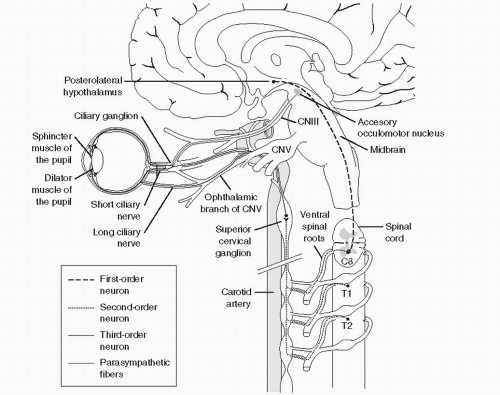Horner’s Syndrome: Incidence, Etiology, Treatment Options, and Outcomes
Cliff Tribus
Perhaps because of its famous eponym or because it has no real treatment, the triad of ptosis, miosis, and anhidrosis, commonly termed Horner’s syndrome, is one of the most widely recognized complications of spinal surgery (1). Its incidence, however, is quite rare in comparison to its recognition. The incidence, pathoanatomy, avoidance, and treatment of Horner’s syndrome is presented in this chapter.
PATHOANATOMY
The clinical condition of Horner’s syndrome is a direct result of disruption of the oculosympathetic pathway. Clinically, Horner’s syndrome breaks down into three distinct pathologic entities: central, preganglionic, and postganglionic. The triad of ptosis, pupillary miosis, and facial anhidrosis is a disruption of the sympathetic pathway along one of these three areas (2, 3 and 4).
Ptosis is a result of sympathetic disruption to Muller’s muscle. Muller’s muscle assists in the elevation of the upper eyelid, and in the picture of sympathetic disruption, a subtle closure of the eyelid results giving the clinical appearance of ptosis (4).
Pupillary diameter is a result of balance of sympathetic and parasympathetic inputs to the iris. The iris dilator muscles are sympathetically innovated, while the constrictor muscles are parasympathetically innovated; hence, in the clinical picture of sympathetic disruption, the parasympathetically innovated constrictor muscles are unopposed, resulting in the clinical picture of miosis (4).
Sweat glands located on the face are sympathetically innervated. Sympathetic disruption, therefore, leads to anhidrosis of the effected side. Diagnostically, it is noted that central and preganglionic disruption of the sympathetic pathway leads to anhidrosis of the entire effected side, while postganglionic fibers innervate the sweat glands of the medial forehead only. Therefore, when anhidrosis presents on only the medial forehead, the proximate cause is postganglionic disruption of the sympathetic pathway (4,5).
Enophthalmos is also described as it relates to Horner’s syndrome. In fact, as a clinical triad, it is frequently cited as being present instead of anhidrosis. Presentation, however, of enophthalmos is much more variable in humans than in experimental lab animals. Its presence is accounted for by muscle atrophy of the orbital muscles due to lack of sympathetic tonicity, resulting in a sunken appearance to the orbit (6). An additional explanation other than decreased sympathetic tonicity is that sympathetic retractors to the lower eyelid are also relaxed, which in turn narrows the palpebral fissure. The term upside-down ptosis has been used to describe the phenomenon, which mimics the appearance of enophthalmos (7).
THE OCULOSYMPATHETIC PATHWAY
Anatomic discussions on the oculosympathetic pathway describe three sets of neurons, which articulate at two relay centers (See Fig. 148.1). The neurons are central, preganglionic, and postganglionic. The central and preganglionic neurons articulate at the ciliospinal center of Budge while the preganglionic and postganglionic fibers articulate at the superior cervical ganglion (3).
Given that spinal surgery is not a risk factor for the development of a centrally caused Horner’s syndrome, only a brief account of this anatomic pathway will be given in this chapter. For more detailed description of the central pathway, the reader is referred to works by Harold S. Amonoo-Kuofi.
The central order neurons arise from the posterior lateral hypothalamus, and descend ipsilaterally through the brainstem to the intermedial lateral column of the spinal cord. Multiple other centers contribute to the central pathway and include the insular cortex, amygdalae, parabrachial nucleus, nucleus of tractus solitarius, and ventrolateral medulla (3).
The differential diagnosis of a central Horner’s syndrome includes ischemia, tumor, bleed, and demyelinating
processes, the most common of which is an ischemic syndrome resulting from an infraction of the posterior-inferior cerebellar artery (or pica syndrome). Most of these patients present with symptoms obviously of a central origin, and the Horner’s component is only a subset of the neurologic picture (3,4).
processes, the most common of which is an ischemic syndrome resulting from an infraction of the posterior-inferior cerebellar artery (or pica syndrome). Most of these patients present with symptoms obviously of a central origin, and the Horner’s component is only a subset of the neurologic picture (3,4).
 Figure 148.1. Drawing shows normal anatomy of oculosympathetic pathway. First-order neuron (dashed line) arises from posterolateral hypothalamus, descends into brainstem and intermediolateral column of spinal cord, and exits at cervical (C8) and thoracic (T1-T2) levels of spinal cord as second-order neuron (dotted line). Second-order preganglionic neurons exit ventral spinal roots and arch over apex of lung to ascend in cervical ganglion and exiting as third-order neuron (solid lines). Neural fibers for sweating of face, except medial forehead, travel with external cartoid artery. Third-order postganglionic neuron travels with carotid artery into cavernous sinus and with ophthalmic brand of fifth cranial nerve joins nasociliary branch of fifth cranial nerve or passes through ciliary ganglion directly, reaching eye as long and short ciliary nerves (Reader A. The role of Claude Bernard and others in the discovery of Horner’s syndrome. J Am Coll Surg 2005;200(5):815; Mueller K, Loder R, Eggenberger E, et al. Horner’s syndrome after posterior spinal fusion in a child—a case report. Spine 2000;25(21):2836-2837). Preganglionic parasympathetic fibers (gray lines) arise from accessory oculomotor nucleus, exit as oculomotor nerve, synapse at ciliary ganglion, and reach eye as short ciliary nerves. (Adapted from Lee JH, Lee HK, Lee DH, et al. Neuroimaging strategies for three types of Horner’s syndrome with emphasis on anatomic location. AJR Am J Roentgenol 2007;188:W74.)
Stay updated, free articles. Join our Telegram channel
Full access? Get Clinical Tree
 Get Clinical Tree app for offline access
Get Clinical Tree app for offline access

|




